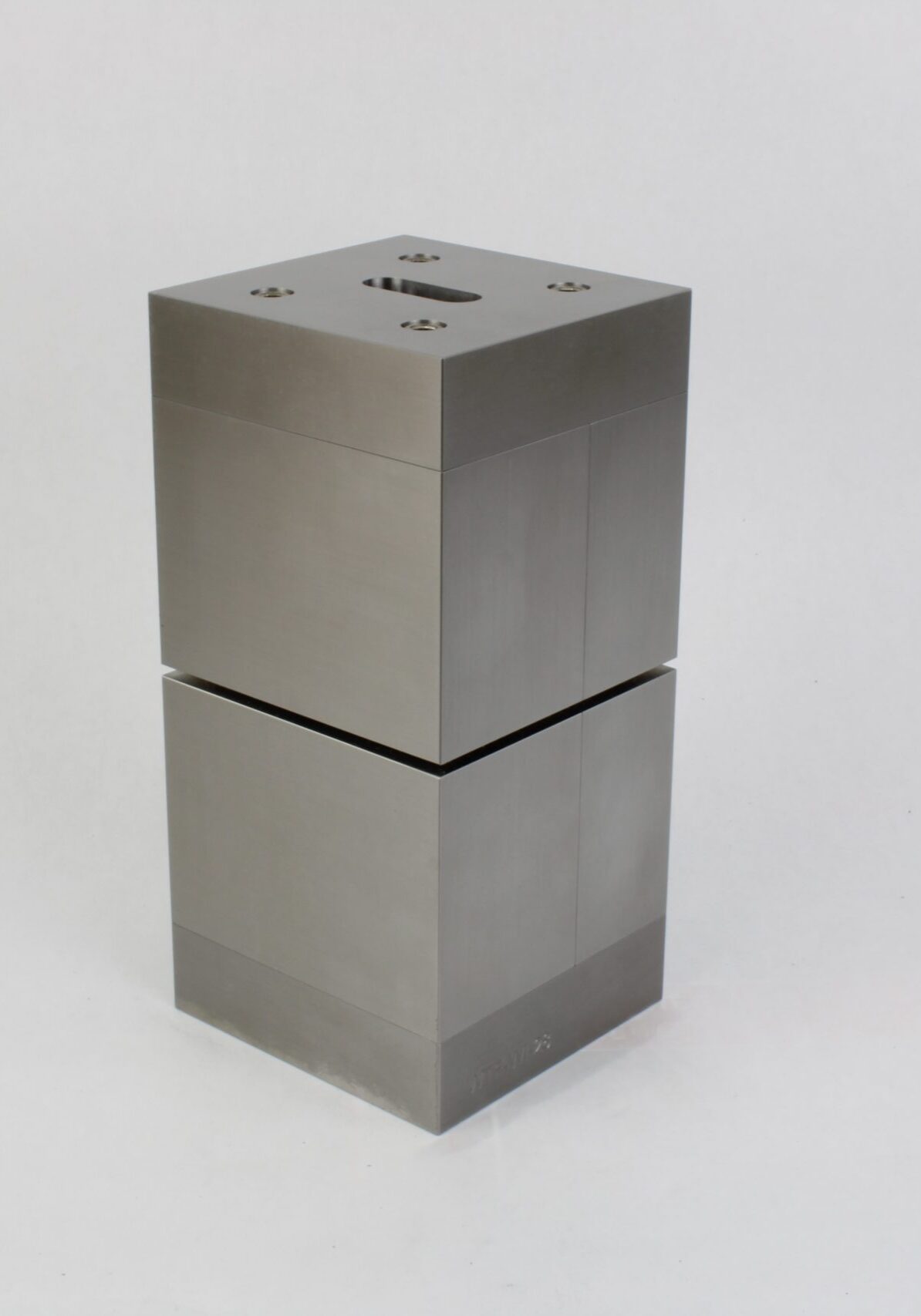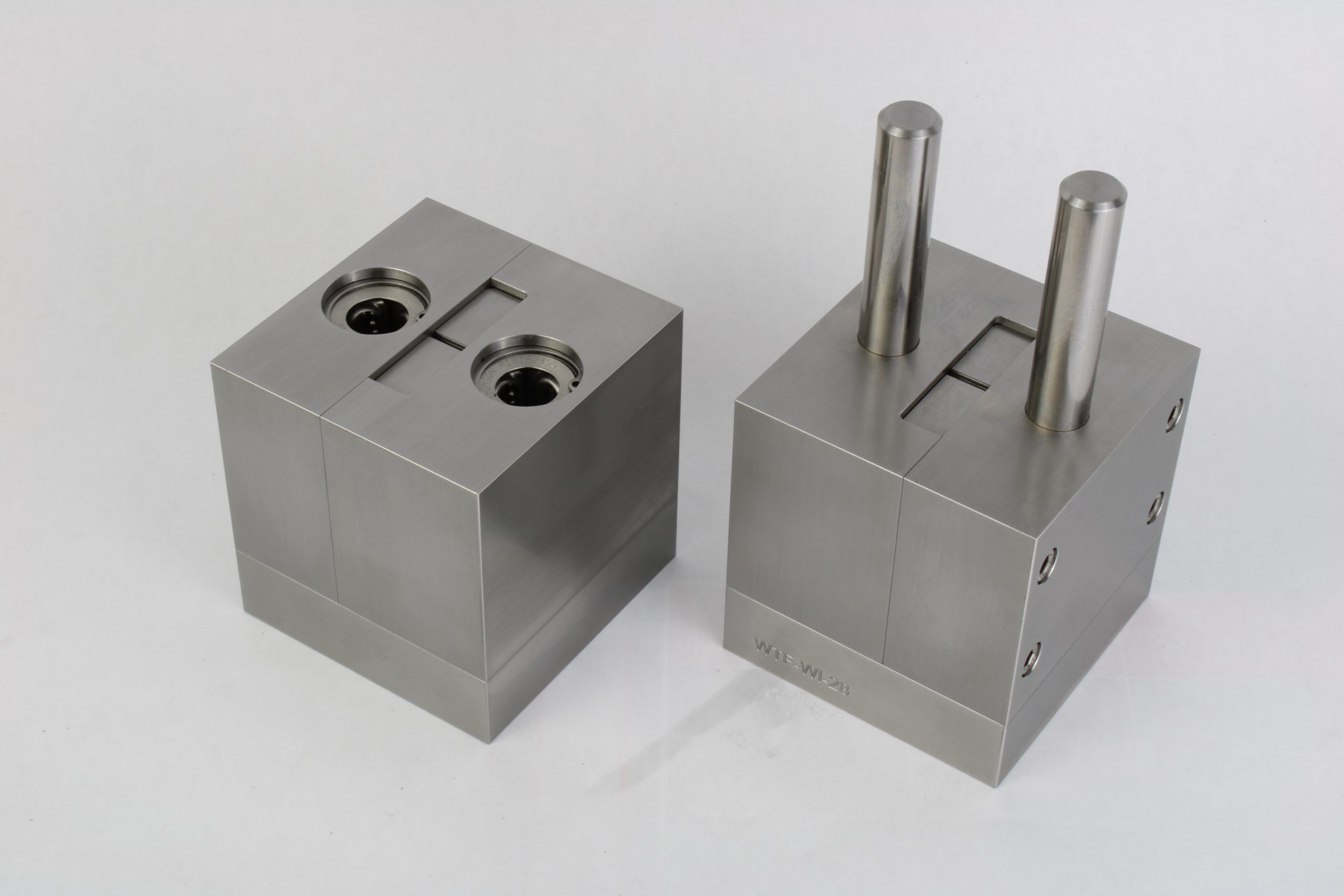Wyoming Modified IITRI Compression Test Fixture
Model No. WTF-WI (Stainless Steel)

Fig. 1: Assembled Wyoming Modified IITRI Compression Test Fixture
The Wyoming Modified IITRI Compression Test Fixture was developed at the University of Wyoming (References 1 through 4) as an alternative to the standard IITRI compression test fixture configuration (ASTM D 3410, Reference 5). It is a smaller version, weighing only 24 lb. compared to 94 lb. for the standard IITRI fixture. Because of this greatly reduced weight, it is much easier to handle in use, and it also costs significantly less.
It incorporates flat wedge grips, just as the IITRI fixture, thus assuring full surface contact with the mating blocks, independent of tabbed specimen thickness. Alignment rods in linear bearings are also used, to eliminate frictional binding between the fixture halves.
Just as the IITRI fixture, the Wyoming Modified IITRI Compression Test Fixture is designed to accommodate ASTM Standard D3410 tabbed specimens 5.5 in. long. However, while the standard IITRI fixture accommodates specimen widths up to 1.5 in., the Wyoming Modified IITRI fixture is limited to specimens not more than 0.5 in. wide. Of course, a narrower specimen can be tested, if desired. For example, the fixture can accommodate a standard Celanese specimen, which is also 5.5 in. long, but only 0.25 in. wide.
in.The Modified IITRI fixture is provided with one set of wedge grips, which will accommodate specimens with thicknesses at the tabbed ends in the range of approximately 0.18 to 0.28 in. (assuming the wedges are flush with the blocks when at the lower end of the range, and protruding a maximum of 0.25 in. at the upper end of the range, a readily acceptable amount).

Fig. 2: Fixture halves separated.
Wedge grips operational over a different range can be supplied upon request. Serrated grip faces are standard. Tungsten carbide particle-coated grip faces can also be supplied upon request.
The standard gage length (distance between tabs) per ASTM Standard D3410 is 0.50 in.. Thus, the tab length for standard specimens used with the Modified IITRI Compression Test Fixture is 2.5 in., the same as for the Celanese and IITRI configurations. The fixture can be used to test nonstandard gage length specimens also, from zero to approximately 1 in. (With longer alignment rods, even longer gage lengths can be used.)
Custom-designed fixtures can be supplied, at reasonable cost, to accommodate specimens with thicknesses outside the standard range, lengths greater than 5.5 in., or widths greater than 0.5 in.
Sources of Additional Information:
1) D.F. Adams, "A Comparison of Composite Material Compression Test Methods in Current Use," Proceedings of the 34th International SAMPE Symposium, Reno, Nevada, May 1989, pp. 1422-1433.
2) J.S. Berg and D.F. Adams, "An Evaluation of Composite Material Compression Test Methods,"Journal of Composites Technology and Research, Vol. 11, No. 2, Summer 1989, pp. 41-46.
3) D.F. Adams and E.M. Odom, "Influence of Test Fixture Configuration on the Measured Compressive Strength of a Composite Material," Journal of Composites Technology and Research, Vol. 13, No. 1, Spring 1991, pp. 36-40.
4) D.F. Adams, "Current Status of Compression Testing of Composite Materials," Proceedings of the 40th International SAMPE Symposium, Anaheim, California, May 1995, pp. 1831-1843.
5) ASTM Standard D3410-03 (reapproved 2008), "Compressive Properties of Polymer Matrix Composite Materials with Unsupported Gage Section by Shear Loading," American Society for Testing and Materials, West Conshohocken, PA (first published in 1975).

